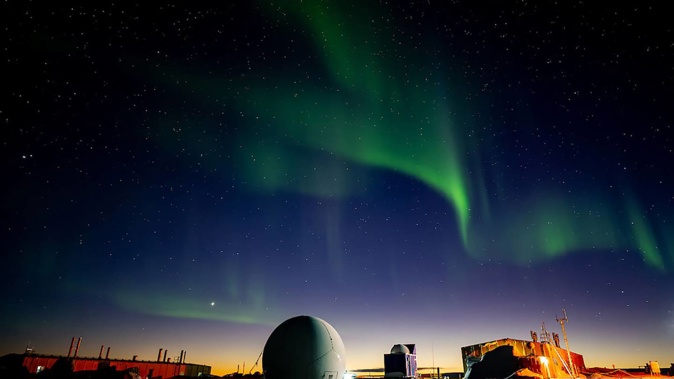
Antarctica in winter, for most people, would be a pretty miserable experience - extreme cold, indoor confinement, and almost permanent darkness.
For Barend (Barry Becker), Antarctica is the place to practice his work as a meteorologist for the Australian Bureau of Meteorology and to pursue his passion as a landscape photographer.
"Winter (on Antarctica) provides amazing opportunities to photograph phenomena that only occur in polar regions," he said.
Becker is currently at Casey Station, about 3900 km due south of Perth, and experiences average maximum temperatures of below -10C degrees and daylight lasting just 2.5 hours. The sun reaches a maximum of one degree when it does crawl above the horizon.
/cloudfront-ap-southeast-2.images.arcpublishing.com/nzme/K3GGL7I7A4TH2JPU4ADGT7I6CI.jpg)
The Aurora Australis above Casey Station. Photo / Barry Becker
Becker writes in a recent blog post: "Over the last few weeks there have been several wondrous long nights when expeditioners have been treated to the aurora australis."
The aurora is caused by solar wind colliding with atoms of oxygen and nitrogen high up in the Earth's ionosphere, releasing energy as colourful light halos and occurring at both poles.
He also describes several other light phenomena unique to these environments and has taken some spectacular photographs to illustrate them.
/cloudfront-ap-southeast-2.images.arcpublishing.com/nzme/6H5UPYQDC7REMQZI3GYNQVYYIM.jpg)
Electrical lights on station, spearing into the night due to the light pillar effect. Photo / Barry Becker
Light and solar pillars – vertical beams of light appearing to extend above and/or below a light source, caused by the reflection from tiny ice crystals suspended or falling through a super cold atmosphere.
/cloudfront-ap-southeast-2.images.arcpublishing.com/nzme/XZUDCQAPH3OZXIUFWBND7CFQ6E.jpg)
Distant icebergs appear to float above the water - Fata Morgana are mirage visible in a narrow band right above the horizon. Photo / Barry Becker
Fata Morgana – a complex form of mirage visible in a narrow band right above the horizon - was named after the Italian name of Morgan le Fay (Morgan the Fairy) from the King Arthur legend. The mirages were believed to be fairy castles or false land conjured to lure sailors to their deaths.
/cloudfront-ap-southeast-2.images.arcpublishing.com/nzme/FN6OJEBZY67SX6STDWBGB5D5UQ.jpg)
A sun dog beside the setting sun - variations on refraction of sunlight through ice crystals in the cold atmosphere. Photo / Barry Becker
Sun dogs, mock suns and parhelia. These are variations in the refraction of sunlight through ice crystals in the cold atmosphere.
/cloudfront-ap-southeast-2.images.arcpublishing.com/nzme/AQFM6HXEYQWVI3VU2M6FJXRVGA.jpg)
Ice crystals in double-glazed windows. The macro lens shows the intricate lace patterns. Photo / Barry Becker
Ice crystals form between panes of double and triple-glazed windows. Becker uses a macro lens to photograph these quite small phenomena, magnifying the crystals to reveal their intricate lattice patterns.
"The Antarctic is such a unique environment and there are so many opportunities to photograph the special things that only can be seen here," Becker writes in his blog post.
If you don't fancy months of extreme cold, captivation and near-permanent darkness, you can enjoy his work instead.
Take your Radio, Podcasts and Music with you









